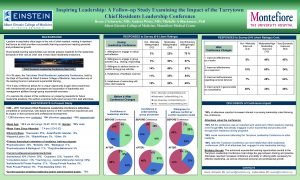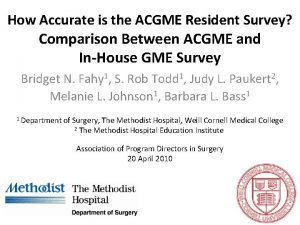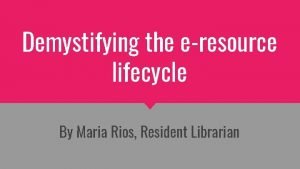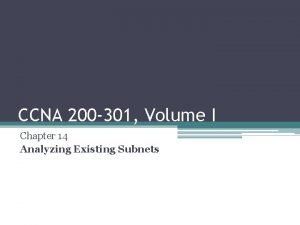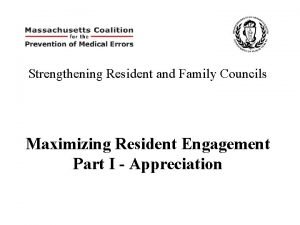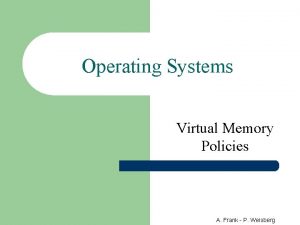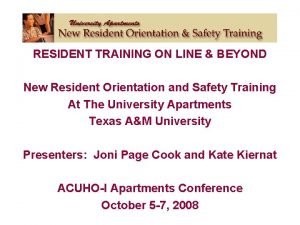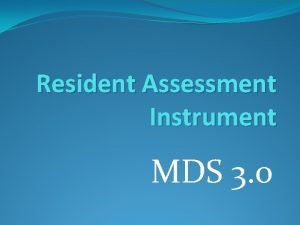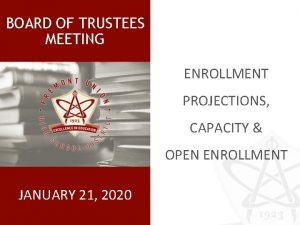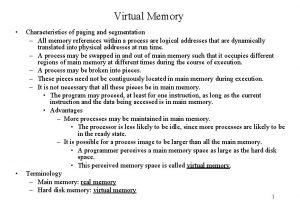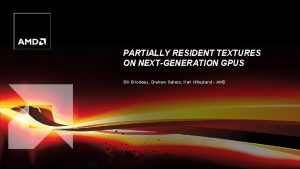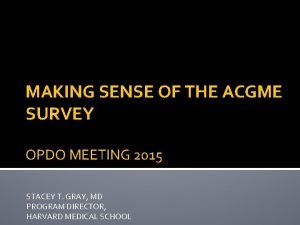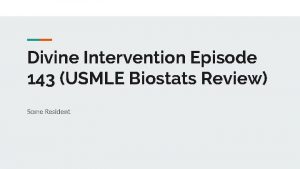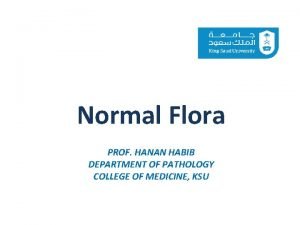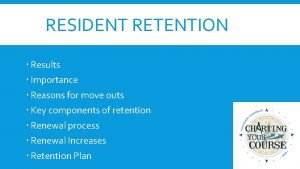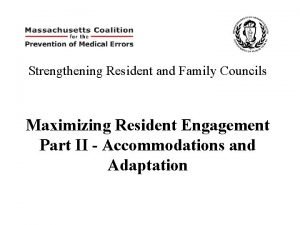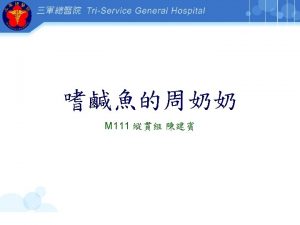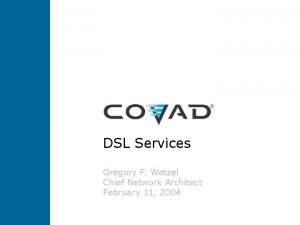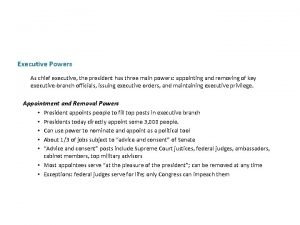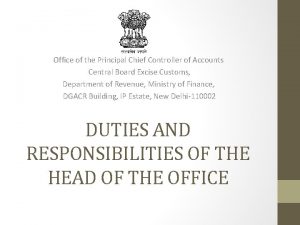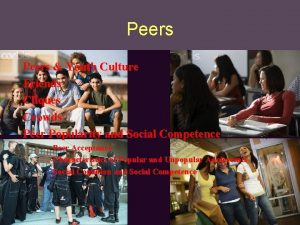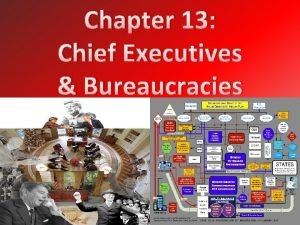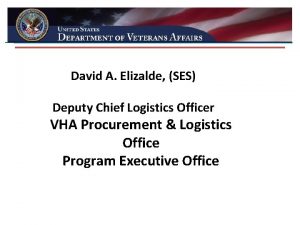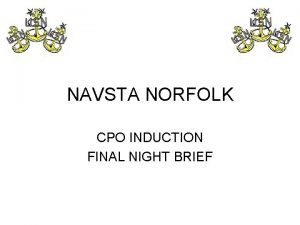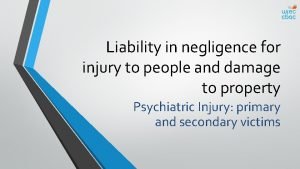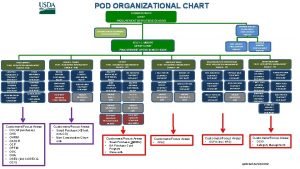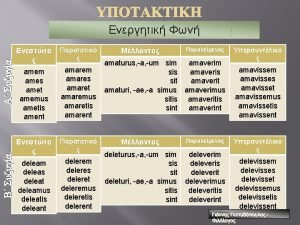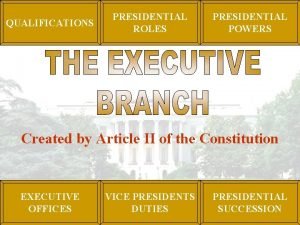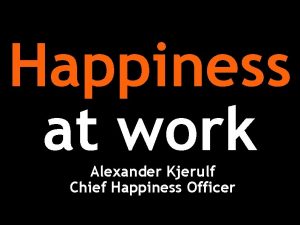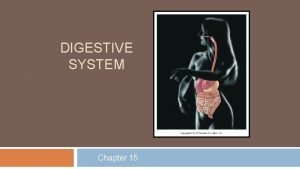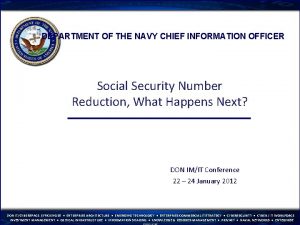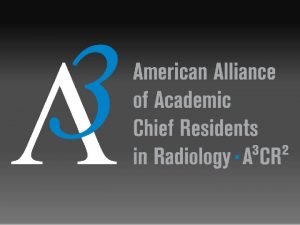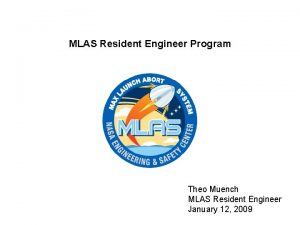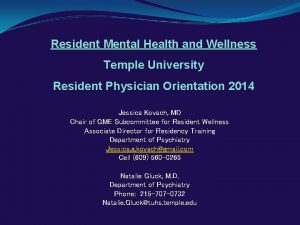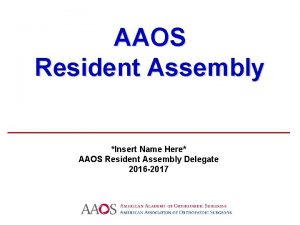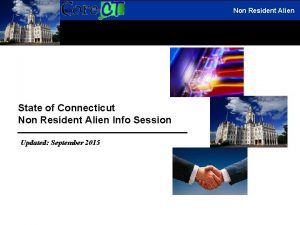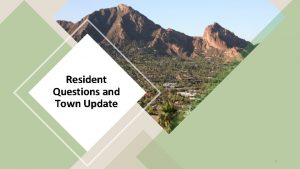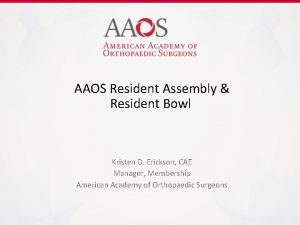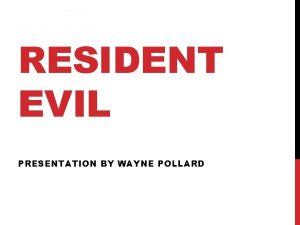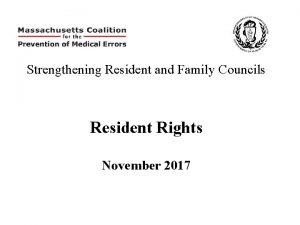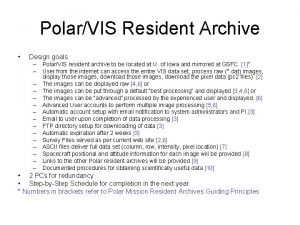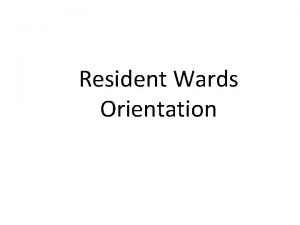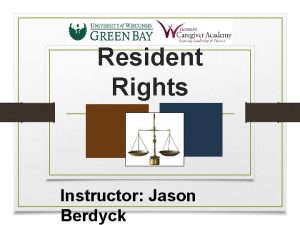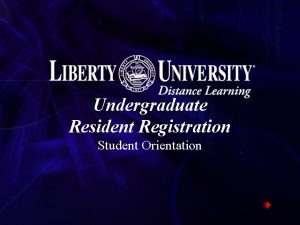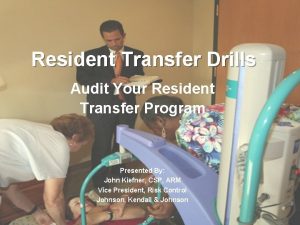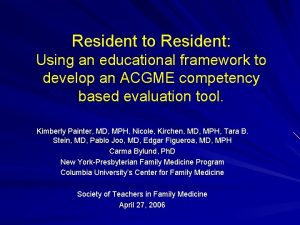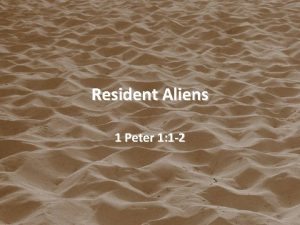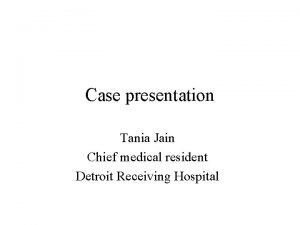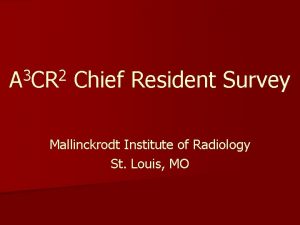3 2 2012 A CR Annual Chief Resident
































































- Slides: 64


3 2 2012 A CR Annual Chief Resident Survey Steve Sauk, MD Mallinckrodt Institute of Radiology

St. Louis AKA The Lou, Mound City, Gateway to the West

Survey Format • Confidential online survey (surveymonkey. com) • Multiple choice questions (single and multiple answer), free text for additional comments

Survey Purpose • Share facts and information about the structure of training programs • Use information about resident benefits to increase benefits at individual programs • Share opinions of fellow chief residents about important issues facing radiology training • Share ideas for how to deal with these important issues

Survey Topics • Recurring – – Basic Program Information and Resident Benefits Chief Resident Responsibilities Call and Outside Hospital Studies New Board Exam Format and its Impact On: • Curriculum, Call System, Fellowships • New in 2012 – Ultrasound and MR interpretations on call – Healthcare Reform and its Economic Impact on Residency Programs, Fellowships, and the Job Market – Quality Improvement

Limitations • Opinions and estimations • Sampling bias (only chief residents included) • Duplicate responses from programs with multiple chief residents – We tried excluding them from the data

PROGRAM DETAILS

Participation Number of Responses 2008 -2012 Year Individual Responses Unique Programs 2012 185 135 2011 259 148 2010 228 140 2009 143 112 2008 100 --- * Out of approximately 218 programs in the US • Results will be available to A 3 CR 2 members by e-mail on request • Results will also be available to A 3 CR 2 members in the newsletter and on the website THANK YOU FOR PARTICIPATING!

Program Size Average # Radiology Residents per Year 35 Changes in Size • Increase in program size over 9 years – Total # residents increased 29% from 2003 to 2012 – # women residents increased 16% from 2003 to 2012 30 25 20 15 10 5 0 2003 2009 2010 2011 2012 Gender Specific # Radiology Residents Per Year 30 25 20 15 Male 10 Female 5 0 2003 2009 2012

Hospital Coverage % of Programs Covering Varying # of Hospitals University Affiliation No 24% Yes 76% 45% 40% 35% 30% 25% 20% 15% 10% 5% 0% 1 2 3 4 5+ 2005 2009 2010 2011 2012 Type of Institution 100. 0% Decrease since 2011 (85%) and ‘ 09 -’ 10 (80%) 80. 0% 60. 0% 40. 0% 20. 0% Level 1 Trauma Stroke Center NIH Cancer Center Pediatric ED More residency programs are increasing # hospitals they cover for training

Volume % Programs with Varying # Radiologic Studies on Selected Years Annual # CT scans (millions) per year* 50% 45% 40% 35% <100 k 30% 29% 25% 101 k-250 k 251 k-500 k 20% 501 k-750 k 21% >750 k 15% 12% 10% 5% 0% 2004 2009 2012 * Brenner DJ, Hall EJ. Computed tomography--an increasing source of radiation exposure. N Engl J Med. 2007 Nov 29; 357(22): 2277 -84

RESIDENT BENEFITS

Resident Benefits 0% 20% 40% 60% 80% Book fund 86. 0% Travel stipend 76. 4% Conference fees 67. 5% Conference Time ABR examination fees 24. 2% 91. 1% AIRP/AFIP housing and/or travel stipend % Residents that attend AIRP = 94% 77. 1% Lead aprons 42. 7% Oral boards review course tuition and/or travel stipend Other Benefits: i. Pads, No healthcare co-pay, Gym membership, Meals 46. 5% STAT Dx 93. 0% RAD Primer E-Anatomy 2008 2011 2012 71. 3% AIRP/AFIP tuition Average Amount = $1793 ($300 -$6000) 100% 34. 4% 16. 6%

Vacation and Salary Average Resident Salary per Class $ 60, 000 $ 58, 000 $ 56, 000 60% $ 57, 535 2009 2012 $ 55, 330 $ 55, 259 $ 54, 000 $ 52, 000 $ 50, 000 % Programs vs. # weeks of Vacation 53% 50% 40% $ 49, 573 34% 30% $ 48, 000 20% $ 46, 000 $ 44, 000 10% $ 42, 000 PGY-2 PGY-3 PGY-4 PGY-5 Resident Salaries have increased 2. 6 % for PGY-2 and 0. 7% for PGY-5 since 2009 1% 1 0% 0% 1. 5 2 2. 5 3% 3 3. 5 1% 4 4. 5 5% 5 3% 5+ 53% of programs offer 4 weeks of vacation 34% of programs offer 3 weeks

Family Leave For Pregnant Residents % Programs offering Family Leave % Programs with Family Leave taken from All, Some, or None of Vacation/Sick Days No 6% For Significant Others of Pregnant Residents No 21% Yes 79% Yes 94% All 24% None 46% Some 30% All 38% None 42% Some 19% % Programs offering Family Leave % Programs with Family Leave taken from All, Some, or None of Vacation/Sick Days

Family Leave % Programs Offering # Weeks of Family Leave for Pregnant Residents % Programs Offering # Weeks of Family Leave for Significant Others 43% 31% 22% 18% 15% 12% 11% 8% 7% 5% 1% 1% 2 -3 4 -5 6 -7 8 -9 10 -11 12 -13 14+ 9% 8% 8% <1 1 2 3 4 5 6 • 5/129 programs report that residents can take more weeks of family leave, unpaid. • Restrictions • Negotiated for programs needs • Medical Necessity 6+

CHIEF RESIDENT

Chief Resident Selection % Programs with Varying # Chief Residents Chairperson / PD only 16% Other 16% 70% Residents only 18% Combination 49% 65% 60% 50% 40% 30% Other 20% All attendings Education Committee 10% 16% 13% 4% 0% 1 2 3 4 0% 1% 5 6

Chief Resident Responsibiltities Call schedule Rotation schedule Vacation schedule Attending lecture / conference schedule Curriculum development and evaluation Resident recruiting Resident selection Social events Managing Disputes Resident teaching Medical student teaching Boards review organization 94. 8% 79. 9% 72. 7% 49. 4% 61. 7% 79. 2% 77. 3% 73. 4% 61. 7% 48. 1% 41. 6% • Others • Budget management • Banquet Planning • Serving on Hospital and GME boards • “Keeping everybody happy” 92. 9%

Chief Resident Benefits 80. 0% 74. 8% 70. 0% 60. 3% 60. 0% 53. 4% 50. 0% 42. 7% 36. 6% 40. 0% 30. 0% 20. 0% 10. 0% Extra time for meetings Costs for conferences paid Time off-service Own/Shared office Salary bonus Average Salary Bonus $1932 (0 -$7500)

CALL, WEEKENDS, AND ATTENDING COVERAGE

Call and Weekend Coverage Type of Reports while On-Call 70% 60% 60% 2011 50% 2012 40% 30% 29% 19% 20% 5% 10% 0% 16% Complete Prelim Short Prelim Report 19% 1% Oral Reports Final Reports Other • Short Prelim for Neuro studies only • Full Report on Radiographs only • Junior resident gives complete prelim report • Senior resident gives short prelim report. • Depends on time of day, or day of the week

Ultrasound Coverage After Hour Ultrasound Coverage US Studies Performed After Hours 100% 44% 29% 38% 13% 20% 16% 0% 0% ist rfo ol Pe di ra No US n. No 0% rm og US rm rfo Pe ts en id 0% Re s Ho m e Ca ll ur So So no no gr gr ap ap he he r r 0% Ho 88% 60% ed 40% 100% 80% 46% 60% 24 100% 2009 2012 80% 40% 29% 20% 0% ED (i. e. gallbladder, appendix, scrotal) Emergent Inpatient (i. e. transplant doppler studies, etc. ) Routine Inpatient Specific Situations Ob-Gyn Service performs Pelvic US Vascular Surgery Service performs DVT US Resident performs certain studies (RUQ, Scrotal, Renal) In-house Sonographer depending on time, hospital, and day of the week

MRI Coverage % Programs Performing MRI Exams After Hours 100% 97% 80% 65% 54% 40% 60% 47% 20% 4% ne No ar cu l 40% 20% 14% 12% 6% 0% On-Call Fellows Attendings Not read Residents ur o M us cu Va s lo s ke le ta l y Bo d an d Sp in e) 0% in 95% 80% 60% (B ra Who Reads the MR Examinations After Hours? Ne Specific Situations Emergent MR Examinations only “STAT” Examinations only ER or Inpatient MR Exams only Residents provide Prelim Reports Telerad service reads MR exams Read only by request (i. e. if clinician calls) Complex cases read by attending only Depends on study (i. e. Cardiac read only by fellows)

Weekend Coverage % Programs Covering Routine Radiology Services Over the Weekend 100% 90% 2010 80% 2011 70% 2012 60% 58% 50% 49% 40% 30% 20% 10% 23% 19% 16% 0% Half Day Saturday Full Day Saturday Half Day Sunday Full Day Sunday Not provided

Readout Process How often are face-to-face readouts performed? 100% 90% 80% 2011 70% 60% 50% 47% 2012 48. 6% 40% 30% 22% 20% 14. 6% 22% 20. 8% 10% 0% Most/All of the Time Some of the Time No face-to-face Readout 16. 0% In-house attending all night Specific Situations Face-to-face readout for Neuro Studies only Face-to-face readout for junior residents only Face-to-face readout only if there is a question on the study

After Hour Attending Coverage 0% 20% 40% 60% 80% 100% Attgs go home at end of work day 46% Attgs are in-house for extended hrs Attgs are in-house 24/7 Attgs review cases from home 45% Other 2010 2011 2012 20% implement extended in-house attending coverage (5 -10 pm) within the next year implement overnight in-house attending coverage within the next year 35% 55% programs do not plan to implement extended inhouse attending coverage 12% 16% 10% programs plan to 7. 5% programs plan to 3% Attgs review only cases residents call about External telerad service over-reads on-call 2009 • Only Neuro studies read by attendings after hours • Depends on the day of the week

CHANGING BOARD EXAMINATION

Changing Board Examination Sentiment re: New Board Exam Format Advantages Expressed 70% Ø Incorporates physics into clinical knowledge Ø Removes 4 th year hiatus for oral boards prep Ø Encourages more trainees to pursue fellowships Ø Allows more focused training during 4 th year 62% 60% 50% 40% 30% 23% Disadvantages Expressed 20% 9% 10% 7% 1% 0% Very Positive Mixed Negative Very Negative Ø Decreased emphasis on Verbal Communication, an invaluable skill Ø 15 month wait period postgraduation to be board-certified, making it more difficult to find a job

Changing Board Examination Plans to change to the new 3 yr “core” curriculum 50% 46% 45% 41% 2010 40% 35% 34% 35% 2011 30% 25% 19% 20% 18% 13% 15% 10% 5% 17% 5% 7% 7% 0% 3 yr "core" Plan to have a 3 yr No plan to change to curriculum in place "core" curriculum by "core" curriculum 3 yr "core" 2013 after 2013 curriculum

Changing Board Examination Plans for 4 th year (Pgy-5) once the new examination is in place 0% 10% 20% Continue normal rotations 30% 21% 40% 50% 61% 7% Start fellowship ("3 + 2" curriculum) Fill in Deficits from 1 st 3 yrs Combination 6% 1% 2011 1% 2012 12% 16% 17% Other Plans 15% 23% Not yet decided Other 70% 26% Selectives / "mini-fellowships" Research 60% 18% 13% 29% Continue fulfilling Mamms and Nucs requirements Remediation in sections of poor performance “Mini-fellowships” are optional

Changing Board Examination Plans for 3 rd years (PGY-4) preparing for the “core” examination 0% 10% 20% 30% 40% 50% 2011 25% Giving time offservice 21% 50% Taking time out of call-pool No protected study time Specific Management Issues 13% § 40%§ § 2 -3 months off the call-pool Placed on lighter rotations Afternoons off for 1 -3 months No nightfloat 3 -6 months prior to exam Negotiations with faculty 11% § Any combination of the above 36% Not Sure 45%

Changing Board Examination Plans for board reviews for the new board exam structure Current Oral Boards Plans for “Core” Exam 0% 20% 40% 60% 80% 100% 2011 70% Internal board review 79% 84% No internal board review, but time for external review No internal or external board review 80% 2011 2012 1% 3% 60% 50% 40% 30% 20% 13% 67% 2012 15% 20% 13% 12% 4% 10% 0% s ge s 2% e w w r su vie t e e r r c c No rd rd na a a ny no r o o a / b b te al ex few hm all n t r i r h p o t w te ef wi Sto w ex e m i w i e t u ie ev ev tin ow dr l R l n r a rd Co oa w, oa lb e i a B v rn al re te rn d n r e I oa Int lb a n er nt i p Sto n ha ge iew v l re

FELLOWSHIPS

Fellowships How are fellowship applicants interviewed? 100% This fellowship program interviews outside applicants before offering positions to internal candidates 90% 80% 70% This fellowship program has an early acceptance policy in place for internal candidates 60% 50% 40% 30% There is no fellowship program for this subspecialty at my institution 20% 10% Ab do m en Bo dy Br ea s Ca t rd ia c Ch es t M RI M SK Ne u Ne ro ur o IR Nu cs Pe ds VI R 0%

Fellowships What fellowships are the 4 th years (PGY-5) going into? 25% 2009 2012 22% 20% 19% 14% 15% 12% 15% 13% 12% 11% 10% 6% 5% 5% 5% 4% 2% 1% 2% 2% 0% 2% 1% 1% r R VI ds Pe cs Nu Ot he Ne ur o. I R o ur Ne SK M RI M st Ch e ac di Ca r t as Br e y Bo d Ab do m en 0%

Fellowships Distribution of Internal vs. External Fellowships (2012) 25% Internal Fellowship External Fellowship 20% 12% 15% 13% 7% 10% 8% 3% ED Combined Private practice 9% 1% 2% he r Ot R 0% VI 1% 1% Pe ds 0% 0% Nu cs 6% Ne ur o. I R M RI M t SK 2% 1% es ac 8% 2% 1% 1% 1% rd i ea s Br dy Bo m en Ab do t 4% 2% 0% 5% Ch 3% Ca 5% 6%

Fellowships How is your institution planning on dealing with the expected increase in fellowship applicants once the new board format is in place? Expanding # programs Increasing # positions 3% 4% 2% Filling more positions internally 2% No plans to change Not sure 2012 3% Move at least some fellowship training into 4 th year Filling more positions externally 2011 9% 2% 1% 1% 3% 38% 39% 50% 56%

Fellowships Sentiments re: Change to limit interviews starting Feb. and offers to external candidates starting May of the R 3 year Preference for the fellowship application process 0% 0% 10% 20% 30% 40% I agree with the change, it will make the process more fair 30% I agree, but it will be difficult to enforce these new limitations I disagree with the change I have no strong opinion either way Comments: 28% 8% Same application process (i. e. internal filling, variable application deadlines) “Encourages residents to stay at their program” “Collides with ‘core’ exam prep” Both a match process and a common deadline 40% 60% 33% 2011 23% 2012 28% Common deadline for all fellowship applications Match process for all fellowship positions 35% 20% 46% 11% 5% 28% 26%

HEALTHCARE ECONOMICS AND THE JOB MARKET

Healthcare Economics and the Job Market Sentiments about Current Job Market 45% 2011 34% 35% 36% 38% 29% 30% Yes 24. 7% 23% 25% 20% Already have one 7. 8% 2012 40% Have you started looking for a job? 18% No 67. 5% 15% 9% 10% 4% 5% 0% Very worried Worried A little worried Not worried

Healthcare Economics and the Job Market SHORT-Term Plans After Graduation Academic 3% Military Service 3% Private Practice 3% LONG-Term Plans After Graduation Military Service 3% Academic 27% Fellowship 92% Undecided 33% Private Practice 38%

Healthcare Economics and the Job Market How the Current Economic Environment and Current Job Market Influences Career Plans* 50% 45% 40% 35% 30% 25% 20% 15% 10% 5% 0% 60% 25% 50% 48% 44% 36% 40% 30% 16% 10% 20% 3% 10% tio n l lo ca Le ss id ea ke nd sh ift hi ft ee M or e w M or e ca ll s la sa er w s s ry e tim n tio ca va ss Lo ch ip sh el lo w Le an ce oi sh w fe llo in do Ch in st er e De cr ea s es i nt ip ip w ga ga in do n st i re te in se s ea ge sf ap e m or ad e m ice cr fe llo pe al pe ap e or m e ad ac t pr In sh in in al ni an pl re er m g g ng 0% ice ct Pr a 42% 50% ics em ad Ac 70% 45% ca on ce en flu in o le /N Lit t What are you willing to compromise to obtain a job? ** * Similar trend in 2011 ** Some not willing to compromise anything for a job

Healthcare Economics and the Job Market What effects do you think healthcare reform will have on radiology? • 86% feel practices will try to increase their volume to maintain a similar salary despite the lower reimbursement rates • 65% feel it will discourage top-tier medical students from choosing radiology – 5% feel it will encourage top-tier medical students to choose radiology • 36% feel that practices are going to be looking for radiologists trained in more than one fellowship • “Worst possible effect. Game over. Medicine as we know it is done. ” Does your program offer some training in healthcare economics and radiology business? Adequat e 30% None 36% Inadequa te 34%

Healthcare Economics and the Job Market Poor economic climate has lead to budget issues at some programs, esp. programs that have more trainees than its training “cap, ” paying for a certain # trainees out of pocket. such programs may need to downsize # trainees • 51% programs with # trainees = training “cap” • 13% programs with # trainees > training “cap” • 16% programs planning on increasing # trainees • 4% programs planning on decreasing # trainees • 44% programs not planning on changing # trainees

QUALITY IMPROVEMENT AND AUDIENCE RESPONSE SYSTEMS

Quality Improvement How well does your training program prepare you for ABR’s PQI requirements? ABR requires radiologists to document participation in 3 successful PQI projects every 10 years to maintain board certification How many PQI projects have you taken part in? 40% 45% 40% 25% Inadequate 20% Adequate 62% What does your program do to support residents on PQI projects? 70% 60% 35% 30% Not at all 18% 27% 25% 40% 20% 30% 15% 2% 5% 0% 1 2 3 27% 18% 20% 7% 10% None 48% 50% 4+ 10% 2% 0% Nothing Provide Financial time off- support service Provide faculty resources advisors

Audience Response How often are Audience Response Systems used? 60% How useful are Audience Response Systems? 40% 52% 50% 36% 35% 30% 40% 35% 21% 20% 30% 15% 20% 10% 25% 10% 9% 6% 5% 0% 0% Frequently Rarely Used Not Used Valuable Tool Waste of Time, Mixed feelings Detracts from Learning

DISCUSSION

Discussion Program Details • Interval decreased number of responses compared to 2011, but increased since 2009 – likely related to shorter time frame to complete the survey this year • Total # residents increased 29% from 2003 to 2012, with a proportionately smaller increase in percentage (16%) of women residents from 2003 to 2012 • Decrease in university affiliation from 85% to 76% since 2011 • Hospital Coverage and Volume – Overall increase in the number of programs which cover 4 or more hospitals since 2005 (44% increase) – 140% increase in programs which read > 750 k radiologic studies • Reflective of the general trend of higher volume of radiologic studies in the US

Discussion Resident Benefits • Interval increase in overall benefits since 2008 – Book funds, conference fees, ABR examination fees, Lead aprons, oral board review course tuition/travel stipend – AIRP coverage varies from %300 -$6000 (average $1793), with ~94% residents attending AIRP • 2. 6% and 0. 7% increase in resident salaries since 2009 for PGY 2 and PGY-5, respectively • 90% programs offer 3 -4 weeks of vacation • Family Leave – 94% and 79% programs offer family leave for pregnant residents and significant others, respectively – 46% and 43% programs offer family leave without taking from some/all vacation/sick days • Vast majority of programs offering 6 -7 weeks and 1 -2 weeks of family leave for pregnant residents and significant others

Discussion Chief Residents • 49% programs choose their chief residents by a combination of program director/chair + resident • 81% programs have 2 -3 chief residents • Responsibilities managed by majority of programs – Call schedule*, Rotation Schedule, Vacation Schedule, Curriculum development and evaluation, resident recruiting/selecting, social events, managing disputes*, and teaching residents • Responsibilities managed by a minority of programs – attending lecture / conference schedule, medical student teaching, boards review organization, budget management, banquet planning, and serving on hospital/GME boards • Majority of programs offer extra time/paid fees for conferences and salary bonus (average = $1932)

Discussion Call, Weekends, Attending Coverage • Slight increase in the number of final reports given while on-call with decline in number of oral reports since 2011 • Ultrasound Examinations – Who performs them? • 59% increase in programs with 24 -hour sonographer coverage – may depend on hospital, time, and day of the week • 14% decrease in programs with home-call sonographer • 23% increase in programs with residents performing ultrasounds while on-call • Specific Situations – Ob-Gyn performs Pelvic US – Vascular surgery performs DVT studies – What kinds of studies? • all programs perform ED ultrasounds, and 88% perform emergent inpatient ultrasounds

Discussion Call, Weekends, Attending Coverage • MRI Examinations – Majority of programs performing Neuro and Body MRs – 54% performing musculoskeletal and vascular studies • What indications? • Are these read overnight or read the next day? – 95% progams have the on-call resident read the MR examinations over night • Type of report variable prelims, depends on the study • Weekend Coverage – Minimal change in % programs covering services over the weekend • Majority of programs working full day Saturday • 49% programs provide services on a full day Sunday – Why? • Increase in radiologic studies would be too overwhelming for the following Monday? • Higher demands from clinical services for imaging over the weekend? • How much of these examinations change the management over the weekend?

Discussion Call, Weekends, Attending Coverage • Read out Process – % programs doing face-to-face readout hasn't changed since 2011 • Attending Coverage – 67% increase in 24/7 in-house attendings since 2009 (12% 20%) – 41% increase in extended hour in-house attendings since 2009 (32% 45%) – ~18% programs plan to implement either 24/7 or extended hour attending coverage next year – Why? • A result of clinical services demanding final reads during the night? • How much resident variance is there?

Discussion Changing Board Examination • How do people feel about the new board exam format? – Majority = mixed + negative – Major disadvantages = decreased emphasis on verbal communication and delay in being board-certified • Will this affect the clinicians interactions with radiologists? • Will this affect the job search after several years? • Implementing the 3 year "core" curriculum – # programs with 3 year curriculum have increased 7 -fold since 2010 – 17% programs do not plan to change to a 3 year core curriculum – What will 4 th years do? • Selectives / mini-fellowships • Continue normal rotations • Less common: start fellowship, fill in deficits from the first 3 years

Discussion Changing Board Examination • How will you manage 3 rd years preparing for the "core" examination? – 75% programs plan to have them take time out of the call pool or time off-service (increased since 2011) • Variable amount of time (1 -3 months) – How will they make up for the time off-service or off-call, if at all? – Who will cover for their call? 4 th year class? 2 nd year class? • How will 3 rd years study for their "core" examination? – 67% programs are not sure – 15% programs keeping the same internal board review, while there is an general increase in % programs stopping internal board review, to allow time for external review

Discussion Fellowships • Large majority of fellowship programs has an early acceptance policy for internal candidates – disadvantage for those applicants in programs without specific fellowships • % applicants going into fellowships since 2009: – Decreased: Breast (13% 11%), MSK (19% 14%) Neuro IR (2% 0%) – Increased: Neuro (15% 20%), Peds (2% 5%), VIR (15% 22%) • For these fellowships, there is a larger percentage of fellows from outside institutions than from within the same institution

Discussion Fellowships • Once the new board format is in place, an increase in fellowship applicants is expected – majority of programs do not plan to expand their programs or are not sure • Fellowship interviews will start Feb 2013 with offers given starting May 2013 – Majority agree that the change is more fair, but may be difficult to enforce – strong sentiment about interviews occuring the same time during "core" exam prep – Majority would prefer a common deadline for all fellowship applications (increased in number since 2011)

Discussion Healthcare Economics and the Job Market • Increased concern about attaining a job since 2011 – People willing to compromise lower salary over vacation time, location, and call/weekend shifts to obtain a job • Majority have not start looking for a job – Short-term, 92% going into fellowships – Long-term, split nearly evenly between academics, private practice, and undecided • Similar impact of the economic environment and current job market on residents this year, compared to 2011 – Majority feel little/no influence on career plans – Majority feel that the economy increases the interest in doing fellowship

Discussion Quality Improvement and Audience Response Systems • 62% programs feel their training program prepares them for the ABR's PQI requirements – May be reflective of the 75% those surveyed who have taken part of a PQI project this year • 36% those surveyed feel audience response systems is valuable

Future Directions • Continued impact of new board exam format • Continued impact of evolving ACGME duty hour restrictions • New ideas for the upcoming 2012 -2013 academic year in light of the new “core” examination

Thanks! • Chief Resident Participants • Laurie May at RSNA • Gautham Reddy and the A 3 CR 2 Leadership • Jennifer Gould and Ron Evens • Clint Jokerst, Amy Fowler, Doug Kitchin, Elizabeth Sheybani, and Colin Thompson • To Request Data from this Survey: Ssauk@mir. wustl. edu
 Tarrytown chief resident conference
Tarrytown chief resident conference Chapter 9 lesson 3 commander in chief and chief diplomat
Chapter 9 lesson 3 commander in chief and chief diplomat Employment of non-resident aliens in the philippines
Employment of non-resident aliens in the philippines Acgme resident survey
Acgme resident survey Pab ankle fracture
Pab ankle fracture Resident lifecycle
Resident lifecycle Resident subnet
Resident subnet Chapter 19 confusion dementia and alzheimer's disease
Chapter 19 confusion dementia and alzheimer's disease Resident and family engagement
Resident and family engagement Placement policy in os
Placement policy in os Telephone 911
Telephone 911 Describe the care team and the chain of command
Describe the care team and the chain of command Resident assessment instrument definition
Resident assessment instrument definition When ambulating a resident should be wearing
When ambulating a resident should be wearing Ota core curriculum
Ota core curriculum Means
Means What is conflict resolution in customer service
What is conflict resolution in customer service Attending vs resident
Attending vs resident Resident set management
Resident set management Transamerica estate planning foreign nationals
Transamerica estate planning foreign nationals Partially resident textures
Partially resident textures Acgme survey
Acgme survey Divine intervention resident
Divine intervention resident Define resident flora
Define resident flora Examples of misappropriation of resident property
Examples of misappropriation of resident property Resident retention
Resident retention Resident and family engagement
Resident and family engagement Chief complain
Chief complain Chief network architect
Chief network architect Ibm chief data officer
Ibm chief data officer Chief angaska
Chief angaska Chief executive powers
Chief executive powers Principal chief controller of accounts
Principal chief controller of accounts Chief engineer of the union pacific railroad
Chief engineer of the union pacific railroad Clique vs crowd
Clique vs crowd Jump rope rhymes boyfriend
Jump rope rhymes boyfriend Chief executives and bureaucracies
Chief executives and bureaucracies Chief contracting officer
Chief contracting officer Sohcatoa
Sohcatoa First 90 days as chief of staff
First 90 days as chief of staff David elizalde
David elizalde Chief executive boards international
Chief executive boards international Chief instructional officers california community colleges
Chief instructional officers california community colleges Karnataka chief minister bs yediyurappa
Karnataka chief minister bs yediyurappa Diffrentional
Diffrentional Chief final night
Chief final night Chief tomochichi
Chief tomochichi George cassutto
George cassutto Alcock v chief constable of south yorkshire
Alcock v chief constable of south yorkshire Silver chief mine superstition mountains
Silver chief mine superstition mountains Chief procurement officer organization chart
Chief procurement officer organization chart Ransom of red chief plot diagram
Ransom of red chief plot diagram Battalion chief interview questions
Battalion chief interview questions Chief technologist
Chief technologist The six commandments of the catholic church
The six commandments of the catholic church Chief agenda setter examples
Chief agenda setter examples Chief happiness officer portugal
Chief happiness officer portugal What quite unmanned in folly
What quite unmanned in folly Office of the government chief information officer
Office of the government chief information officer Tamil nadu cm special cell
Tamil nadu cm special cell Chief marine group
Chief marine group Chapter 15 digestive system
Chapter 15 digestive system Navy chief information officer
Navy chief information officer Chief turnaround officer
Chief turnaround officer Chief diplomat def
Chief diplomat def
